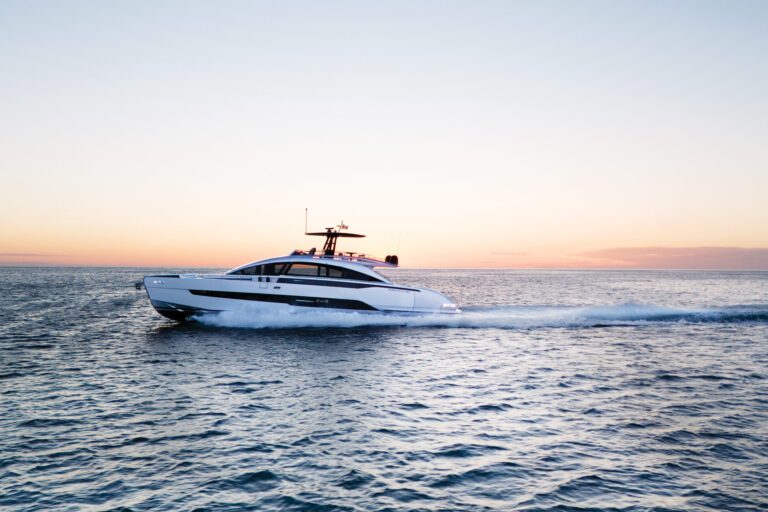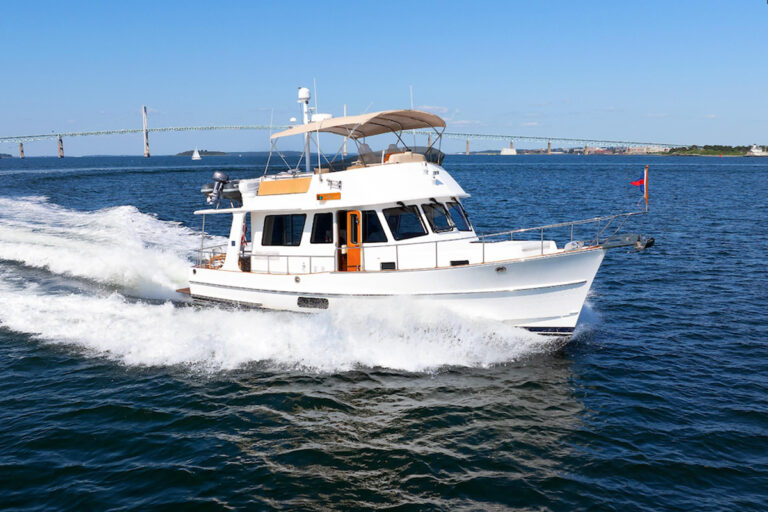
ytgmar09marit445.jpg
Australian boatbuilder Maritimo has been introducing new models at a rapid-fire pace during the last four years. The 60 Sport Cabriolet is the latest to arrive on these shores and I was eager to shake her down and go cruising. My first plan was to head over to the Bahamas, maybe Bimini or Port Lucaya on Grand Bahama. When Steve Martin of Maritimo dealer Yacht Blue informed me that Dean and Brenda Ducray-the owners of a 60-foot Maritimo enclosed flying bridge cruiser-also had the cruising itch, I began to plan in earnest.
The weather, always a concern when making a Gulf Stream crossing, became a factor. If need be, our alternative route was to scrap the Bahamas altogether and head down to the Florida Keys. The first front came barreling in two days before we were to leave. By the time I showed up in Ft. Lauderdale, it was all but a foregone conclusion that we were headed southwest instead of east. With 20 to 25 knots of wind and the 36-hour forecast calling for yet another pesky front to pass through the area, I would have plenty of help evaluating the boat’s seakeeping prowess on our southern cruise.
The Ducrays, their skipper Rob Welling, Yacht Blue’s mobile service technician Tony Schulstad, photographer Scott Pearson, Martin, and I assembled in the wide-open spaces of the 60 Cabriolet’s salon. We had lots of room to sit and plan while lounging on the leather settee to starboard and seating area to port. “We’ll most likely have the seas on our port bow until we make the channel just past Elliot Key,” I offered.
“Once we jog to the west a bit there, it’ll be smoother on down to the middle keys,” Martin added. Since he had already called ahead to Duck Key, all we had left to do was let go of our lines.
The wind was puffing up some and getting out of the tight spot meant playing a bit of bump and go with the engines and the bow and optional stern thruster. But with her low profile and minimal windage, she responded well to all commands. We cleared the pilings, headed down the canal to the ICW, and out to sea.
Except for the busy Port Everglades tractor tug Broward and several local sportfishing boats, there were few pleasure craft transiting the roller-coaster inlet with us. By the time we cleared the sea buoy and headed south, it began to rain. Not that it mattered, since the four windshield wipers worked full time combating the steady, wind-driven four-footers. Once I found the right rpm, I was impressed that I was able to keep the boat running comfortably at 20 knots and noticed that Pearson was relaxed enough to have fallen asleep on the settee just abaft the starboard helm. The Maritimo’s steering was butter-smooth and highly responsive, thanks to the proprietary power-steering system, a design that has trickled down from the company’s high-powered racing division.
“The bottom is 1½-inch solid fiberglass and the ride we’re getting here is a matter of balance,” said Martin, who sat next to me at the helm as we discussed the 60’s variable-deadrise hull. This design features a 34-degree entry that “warps,” or varies, down to 9 degrees at the transom, resulting in a hull form that is extremely seakindly in rough conditions, and reduces any slamming or pounding at the right speeds. “We also mount the engines more forward with a single, composite athwartships fuel tank amidships for better weight distribution,” said Martin.
Once we turned the corner and things calmed down a bit, and with the rain abating, Martin suggested we eat lunch. He had stocked the full-size refrigerator in the port galley. The galley is just inside the glass sliding doors separating the cockpit from the salon, making it convenient for cockpit entertaining as well. The doors slide and lock to either side, or even in the middle. Martin secured all the doors to starboard and the galley and teak-soled cockpit, with its beautifully finished round teak table and four chairs, became one. A transom console houses an electric grill and makes alfresco dining very convenient. I was now able to ease the throttles up and, with a bit of down trim, had her settle in at 25 knots. At this rate of speed her twin 1,015-horsepower Cat C18s burned just about 70 gallons per hour. Based on her 1,480-gallon fuel capacity, a 470-nautical-mile range could be expected at cruising speed, with a 10-percent reserve.
I scanned the pair of 15-inch Garmin touchscreens and Cat electronic engine displays, all easy to read thanks to a sensible helm layout. The big forward and side windows and the expansive cockpit doors provided excellent views all around, including one of the nowupright Pearson chowing down on a serious sub at the salon table.
Arriving at Duck Key, the sky had cleared but the wind was still blowing. The 60 Cabriolet was given the outside of a long finger dock with the other boat on the inside. After shutting down, we broke out the hoses, soft brushes, and chamois cloths and got busy getting all the salt off from top to bottom. The Ducrays hosted everyone aboard that night for dinner and all had a splendid time.
The 60 has a four-stateroom, two-head layout. The forepeak offers a door to the day-head followed by a single-berth cabin. Directly opposite the head is the over-under port quarters. The amidships master, which I occupied, has a large en suite head and takes full advantage of the 17-foot, 4-inch beam. I found all the quarters to be well appointed with great headroom.
Morning saw some sunshine but no relief from the wind and I could see a lot of white on the ocean side. Over breakfast at the teak cockpit table we pulled out the charts and took a look at the protected waters in back of Long Key, a bit to the north of Duck. “We can pick up Channel Five and do our performance runs on the other side of the viaduct,” I said. Afterwards, we would raft up with the Ducrays for lunch.
With plenty of room to run from Fiesta Key up to Lower Matecumbe and back, I took my time putting the 60 Cabriolet through her paces. From speed runs where she held her course straight and true to noticing how well she backed down; from getting her up and out of the hole and up on plane in 12 to 15 seconds, to just sitting back, optional remote control in hand, the cockpit doors and the sunroof open, this boat is a dream to drive. I hit a top speed of 32.2 knots, noted 30 knots at 2100 rpm, and settled her into a nice laidback cruise speed of 22.5 knots at 1700 rpm, which would give us a 525-nautical-mile range.

| | |
By the time I had finished my diagnostics, Welling had already anchored and I brought the 60 Cabriolet up alongside. While there’s nothing better than getting from here to there and back in a boat, grilling up lunch for the seven of us on a cockpit barbecue comes pretty close. We spent the rest of the now-sunny afternoon gently at anchor.
The Ducrays insisted on hosting everyone again for dinner back at the dock. And as the evening went from salad to dessert and the empty wine bottles began to line up on the galley counter, we noticed a full moon occasionally peeking through the north-racing clouds. We toasted our new friendships, but knew we had to be up early and off the dock in hopes of outrunning the next weather system.
The trip back to Ft. Lauderdale was a mirror image of the one coming down. Running ahead of the fast-moving front, we had quartering seas and intermittent rain all the way from Duck to Key Biscayne and then some really sloppy stuff from Government Cut to Port Everglades. But I was able to maintain an average speed of 24 knots for most of the trip. By the time we pulled into the dock and shut her down, it was really raining. Good thing we got an early start and even better to be on a seaworthy boat, just in case.
Being on the Maritimo 60 Sport Cabriolet for several days offered me a great opportunity to really get to know this boat. I enjoyed my extended time aboard and found her to be a well-balanced blend of comfortable accommodations, practical amenities, and outstanding seakeeping abilities. Like my shipmates, she was an easy-going new friend that I liked from the word go.
Maritimo USA, (425) 614-2628; **www.maritimo.com.au**





